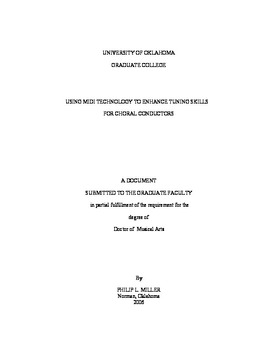| dc.contributor.advisor | Shrock, Dennis, | en_US |
| dc.contributor.author | Miller, Philip L. | en_US |
| dc.date.accessioned | 2013-08-16T12:20:22Z | |
| dc.date.available | 2013-08-16T12:20:22Z | |
| dc.date.issued | 2006 | en_US |
| dc.identifier.uri | https://hdl.handle.net/11244/1091 | |
| dc.description.abstract | Chapter Two provides a background on the development of pitch and temperament along with mathematical calculations for different scales. These calculations provide the framework for the tuning software included with the document. | en_US |
| dc.description.abstract | Chapter Five outlines the tuning exercises for the software and gives instructions on how to access the exercises and the various sounds. | en_US |
| dc.description.abstract | Chapter One of this study describes the importance of intonation study for musicians and the need for tools with which to practice tuning. It also provides definitions for technological and tuning terms along with literature related to tuning, MIDI, and education. | en_US |
| dc.description.abstract | The purpose of this study is to develop and provide software to enhance the tuning skills of conductors. Users of the software will be able to experience and practice tuning within intervals and chord progressions while utilizing a variety of timbres. This is accomplished using MIDI technology and software programmed in "C#" language on the Microsoft.Net Framework for Microsoft Windows. The software uses sampled notes tuned to equal-temperament that can be played back through a pair of computer speakers and then tuned by the user. The user tunes intervals, chords, and chord progressions by moving sliders on the computer screen. For the purpose of this study, just intonation with a moveable "intonation key" is considered to be correct, though tuning to equal-temperament or variations of the two are possible. The computer provides feedback on the accuracy of the tuning as it relates to equal-temperament and just intonation. | en_US |
| dc.description.abstract | Chapter Four provides the details on the development of the software, JustTrainer, included with this document. The procedures for the programming of the software along with instructions for the user are provided. | en_US |
| dc.description.abstract | Chapter Three includes a brief history of MIDI and the development of software utilizing MIDI technology along with an overview of current music software in education and in the recording industry. | en_US |
| dc.format.extent | vii, 110 leaves : | en_US |
| dc.subject | Education, Technology of. | en_US |
| dc.subject | Music. | en_US |
| dc.subject | Education, Music. | en_US |
| dc.subject | MIDI (Standard) | en_US |
| dc.subject | Tuning Software. | en_US |
| dc.subject | Intonation (Musical pitch) | en_US |
| dc.title | Using MIDI technology to enhance tuning skills for choral conductors . | en_US |
| dc.type | Thesis | en_US |
| dc.thesis.degree | D.M.A. | en_US |
| dc.thesis.degreeDiscipline | School of Music | en_US |
| dc.note | Adviser: Dennis Shrock. | en_US |
| dc.note | Source: Dissertation Abstracts International, Volume: 67-10, Section: A, page: 3647. | en_US |
| ou.identifier | (UMI)AAI3237521 | en_US |
| ou.group | Weitzenhoffer Family College of Fine Arts::School of Music | |
